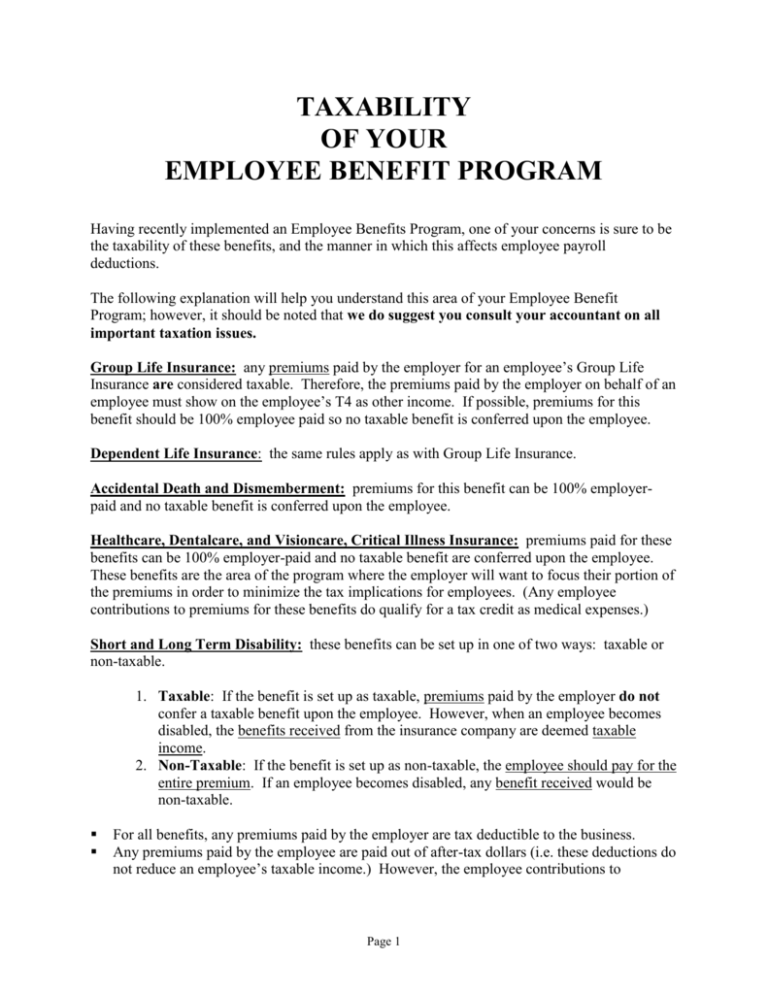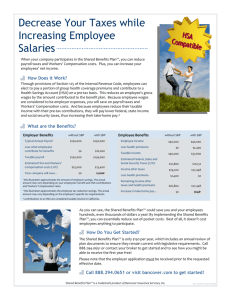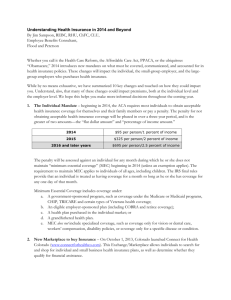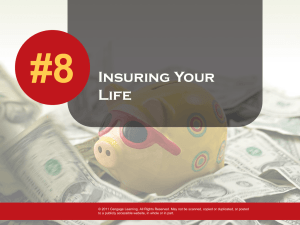TAXABILITY
advertisement

TAXABILITY OF YOUR EMPLOYEE BENEFIT PROGRAM Having recently implemented an Employee Benefits Program, one of your concerns is sure to be the taxability of these benefits, and the manner in which this affects employee payroll deductions. The following explanation will help you understand this area of your Employee Benefit Program; however, it should be noted that we do suggest you consult your accountant on all important taxation issues. Group Life Insurance: any premiums paid by the employer for an employee’s Group Life Insurance are considered taxable. Therefore, the premiums paid by the employer on behalf of an employee must show on the employee’s T4 as other income. If possible, premiums for this benefit should be 100% employee paid so no taxable benefit is conferred upon the employee. Dependent Life Insurance: the same rules apply as with Group Life Insurance. Accidental Death and Dismemberment: premiums for this benefit can be 100% employerpaid and no taxable benefit is conferred upon the employee. Healthcare, Dentalcare, and Visioncare, Critical Illness Insurance: premiums paid for these benefits can be 100% employer-paid and no taxable benefit are conferred upon the employee. These benefits are the area of the program where the employer will want to focus their portion of the premiums in order to minimize the tax implications for employees. (Any employee contributions to premiums for these benefits do qualify for a tax credit as medical expenses.) Short and Long Term Disability: these benefits can be set up in one of two ways: taxable or non-taxable. 1. Taxable: If the benefit is set up as taxable, premiums paid by the employer do not confer a taxable benefit upon the employee. However, when an employee becomes disabled, the benefits received from the insurance company are deemed taxable income. 2. Non-Taxable: If the benefit is set up as non-taxable, the employee should pay for the entire premium. If an employee becomes disabled, any benefit received would be non-taxable. For all benefits, any premiums paid by the employer are tax deductible to the business. Any premiums paid by the employee are paid out of after-tax dollars (i.e. these deductions do not reduce an employee’s taxable income.) However, the employee contributions to Page 1 premiums for Health, Dental, or Vision benefits do qualify for a tax credit as medical expenses. Illustration: Employee A Benefit Life Insurance AD&D Dependent Life Short Term Disability Long Term Disability Health Dental Coverage Premium $25,000 $25,000 $1,200 single single Contributions Employee Employer $9.75 $1.25 $9.75 $1.25 $21.36 $16.55 $34.66 $21.36 $9.42 _______ $7.13 $34.66 $83.57 $41.78 $41.79 - Total Monthly Premiums: Assuming a 50/50 split of the premiums, the employer and the employee would each pay half of the $83.57. By allocating the employer’s contributions towards the Health and Dental premiums, and the employee’s contributions towards the Life, AD&D, and LTD, the tax implications are minimized. Using this method, the employee can receive the benefits without having a taxable benefit conferred upon him or her. This employee would not have to pay income tax on any of the employer’s premium contributions. The employee’s contributions should be listed (including the applicable benefits) on the payroll stub if possible. The most important one to list as being paid by the employee is the Long Term Disability premium (if this benefit is set up as nontaxable). Employee B Benefit Life Insurance AD&D Dependent Life Short Term Disability Long Term Disability Health Dental Coverage Premium $25,000 $25,000 $1,080 family family Contributions Employee Employer $9.75 $1.25 $9.75 $1.25 $19.22 $35.60 $83.54 $19.22 $35.60 $8.86 $74.68 $149.36 $74.68 $74.68 - Total Monthly Premiums: This scenario is essentially the same as Employee A; however, in this case the employee has family health and dental coverage, as well as a lower volume of Long Term Disability insurance. Page 2 Illustration (cont.) Employee C Benefit Life Insurance AD&D Dependent Life Short Term Disability Long Term Disability Health Dental Coverage Premium $25,000 $25,000 $1,386 none none Contributions Employee Employer $9.75 $1.25 $9.75 $24.67 $8.08 **$16.59 _______ _______ ________ $35.67 $17.83 $17.84 $1.25 - Total Monthly Premiums: For Employee C, due to the waiving of Healthcare and Dentalcare benefits, splitting the premiums 50/50 results in the employee’s contribution being less than the Long Term Disability premium. Therefore, the employer must contribute some premium towards the LTD benefit. In order to keep this benefit non-taxable; the $16.59 paid by the employer for the LTD benefit must be declared on the employee’s paystub and on the T4 statement as additional income (T4 Box 40). If you have any further questions regarding the premiums and the taxation of benefits, please phone HMR Employee Benefits Ltd. Toll Free at 1-888-592-4614 or in Victoria at (250) 592-4614 Page 3







